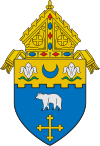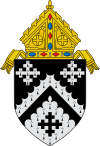Charles Hubert Le Blond
Charles Hubert Le Blond (November 21, 1883 – December 30, 1958) was an American prelate of the Roman Catholic Church. He served as Bishop of St. Joseph from 1933 to 1956.
Early life and education[]
Charles Le Blond was born in Celina, Ohio, one of three children of Charles McGinley and Anne Marie (née Brennan) Le Blond.[1] He belonged to a prominent political family in Ohio; his father was a member of the Ohio House of Representatives from 1886 to 1890, and he was a grandson of Francis Celeste Le Blond and a cousin of Frank Le Blond Kloeb.[2] At age five, he moved with his family to Cleveland, where he received his early education at the parochial school of St. John's Cathedral.[3] He attended St. Ignatius High School for six years, graduating in 1903.[2] He then studied for the priesthood at St. Mary's Seminary, also in Cleveland.[4]
Priesthood[]
Le Blond was ordained a priest for the Diocese of Cleveland on June 29, 1909.[5] His first assignment was as a curate at St. John's Cathedral, where he remained for two years.[4] In 1911, he was named director of St. Anthony's Home for Boys.[2] From 1912 to 1933, he served as the first diocesan director of Catholic Charities and Hospitals.[4] During his tenure as director, he laid a foundation for the many charitable Catholic institutions in the diocese.[3] In 1930, he was one of the delegates sent by the United States to the Pan-American Conference on Child Welfare in Lima, Peru.[6] He also represented the National Catholic Welfare Council at the international conferences on social work in Paris, France (1928) and in Frankfurt, Germany (1932).[6]
Episcopacy[]
On July 21, 1933, Le Blond was appointed the fourth Bishop of St. Joseph, Missouri, by Pope Pius XI.[5] He received his episcopal consecration on the following September 21 from Bishop Joseph Schrembs, with Bishops James A. McFadden and Thomas Charles O'Reilly serving as co-consecrators.[5] He took an interest in welfare work in the city, and was active in the annual Community Chest campaigns.[7] During his tenure as bishop, the number of priests in the diocese increased by 30%, and the Catholic population of the diocese increased by more than 3,000.[7] Due to his failing health, he received Bishop John Cody as a coadjutor bishop in 1954 to manage the daily affairs of the diocese.[8]
After governing the diocese for twenty-three years, Le Blond resigned as Bishop of St. Joseph on August 24, 1956.[5] Following his resignation, the diocese was merged to create the Diocese of Kansas City-St. Joseph.[8] He later died at St. Joseph's Hospital in St. Joseph, at age 75.[9]
Bishop LeBlond High School in St. Joseph is named in his honor.[10]
References[]
- ^ "MRS. CHARLES M. LE BLOND". The New York Times. 1936-05-09.
- ^ a b c Avery, Elroy M. (1918). A History of Cleveland and Its Environs. Vol. II. Chicago: The Lewis Publishing Company.
- ^ a b "LEBLOND, CHARLES HUBERT". The Encyclopedia of Cleveland History.
- ^ a b c Curtis, Georgina Pell (1961). The American Catholic Who's Who. Vol. XIV. Grosse Pointe, Michigan: Walter Romig.
- ^ a b c d "Bishop Charles Hubert Le Blond". Catholic-Hierarchy.org.
- ^ a b "LE BLOND NAMED BISHOP". The New York Times. 1933-07-25.
- ^ a b "Our History". Cathedral of Saint Joseph. Archived from the original on 2010-07-25.
- ^ a b "Our History". Roman Catholic Diocese of Kansas City-Saint Joseph.
- ^ "Most Rev. Charles LeBlond Dies at 75; Retired Bishop of St. Joseph Diocese". The New York Times. 1959-01-01.
- ^ "At a Glance". Bishop LeBlond High School. Archived from the original on 2007-06-07.
- 1883 births
- 1958 deaths
- People from Celina, Ohio
- Roman Catholic Diocese of Cleveland
- Roman Catholic bishops of Saint Joseph
- 20th-century Roman Catholic bishops in the United States
- Catholics from Ohio

